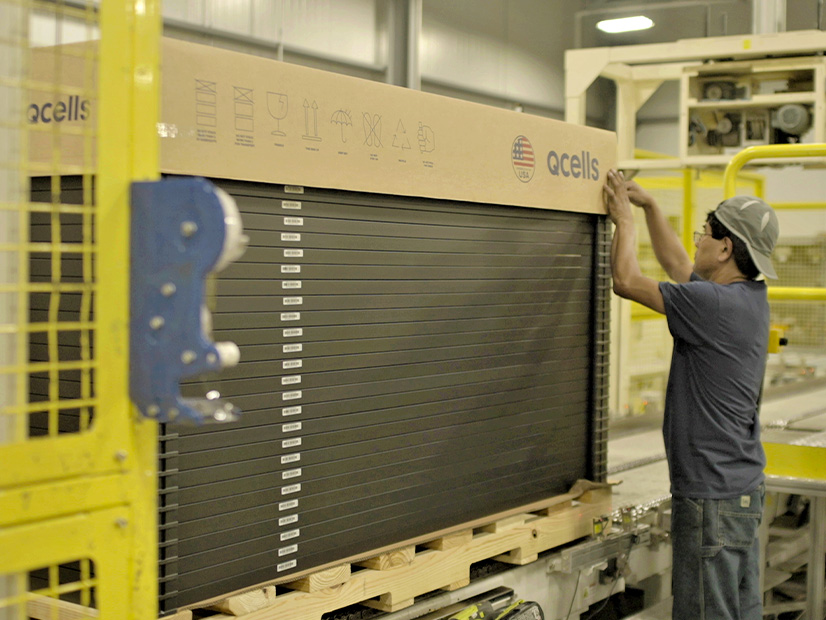
Hanwha Qcells said Wednesday it will spend $2.5 billion to develop a complete solar supply chain in the U.S., the largest solar investment in U.S. history, according to the Biden administration, and further evidence of industry’s response to the clean energy incentives in the Inflation Reduction Act.
Seoul-based Hanwha said its Qcells unit will break ground in 2023 on a factory near Cartersville, Georgia, with capacity to make 3.3 GW of solar ingots, wafers, cells and finished panels.
The company also plans to expand the 300,000-square-foot factory it opened in 2019 in Dalton, Georgia, increasing it from 1.7 GW to 5.1 GW of solar panel capacity.
A worker at Qcells Dalton, Ga., plant prepares solar modules for shipping. | Qcells
The investments would give the company 8.4 GW of capacity by 2024. Qcells, which currently employs about 750 people in Georgia, will expand its workforce there to 4,000.
Hanwha says the buildout of a U.S. supply chain is central to its plan to evolve into an “energy solutions provider” and capitalize on the growth of the solar panel installation market, which is expected to more than double from 19 GW in 2022 to a projected 44 GW by 2026, according to Wood Mackenzie.
Qcells said its investments were triggered by the solar subsidies included in the IRA: It expects to collect $875 million per year by 2026 in investment tax credits and advanced manufacturing production credits.
Companies announced $40 billion in investments on 20 manufacturing facilities between August and December 2022, representing 7,000 new jobs and more than 13 GW of additional clean energy capacity, American Clean Power said in a recent report.
Shares of other solar stocks rose Wednesday following Hanwha’s announcement, with SolarEdge Technologies (NASDAQ:SEDG) shares up almost 6% on the day, while Shoals Technologies (NASDAQ:SHLS) was up 7.4% and Array Technologies (NASDAQ:ARRY) up 9.4%.
Mark Hagedorn, vice president of manufacturing services for Clean Energy Associates, which provides quality assurance, supply chain management and engineering services for the solar PV and battery storage industries, said the scale of the new facilities is creating unique siting challenges.
“If you look at a cell factory, whether it be solar or storage, the size of these things … is huge. They start in the hundreds of acres of space, with millions of square feet under the roof,” he said. “There’s clean rooms involved. There’s lots of power, there’s lots of water; all of that stuff has to be reduced, reused, recycled, optimized.”
Economic Development Agencies Look to Lure Growth
Hagedorn’s comments came at a Solar Energy Industries Association webinar Tuesday on how manufacturers can work with regional economic development agencies to evaluate potential sites for new factories.
“Sometimes we’re [involved] way earlier on in the process. Sometimes, the deals are at the two-yard line, and they need help to get over the goal line,” said Thomas Maynard, vice president of business development for the Greater Phoenix Economic Council.
Maynard said the IRA, which has an estimated $379 billion in clean energy subsidies, and the CHIPS Act, which will spend $54.2 billion to build domestic semiconductor manufacturing, have changed the role of the federal government, which had previously been “pretty hands off” on economic development. “The federal government definitely has a seat at the table and is driving a lot of growth,” he said.
Brock Herr, senior vice president of business retention, expansion and attraction for the Indiana Economic Development Corporation, said his agency has created an interagency affairs division to coordinate efforts with agencies responsible for environmental management, taxes and workforce development.
“We work with them on matters ranging from program and initiative development to make sure that we’re aligned across state government, but then also specific project items — you know, bring them in to facilitate a conversation on permitting,” he said. “We like to act as that concierge, if you will, so a company doesn’t have to cold call various government agencies and explain what they’re doing and why the state or the locality should treat it with the deference that it needs.”
Linda Bonelli, who leads the incentives group in Deloitte Tax LLP’s National Multistate Tax practice, said labor shortages are becoming an increasing concern for manufacturers looking to expand.
“Labor used to be something that … was not as big of a concern. That tends to be people’s No. 1 concern [now],” she said. “The skills we need may not be in that jurisdiction.”
Greater Phoenix’s Maynard had one parting piece of advice for dealing with regional development agencies.
“The ribbon cutting shouldn’t be the finish line. It shouldn’t be the end of the discussion,” he said. “It should be the start of the relationship.”




